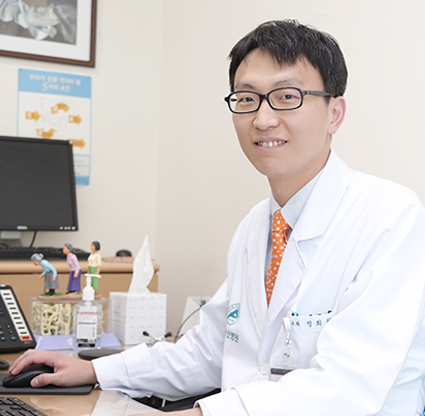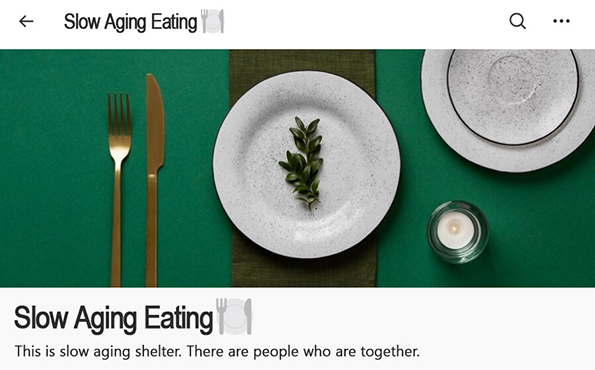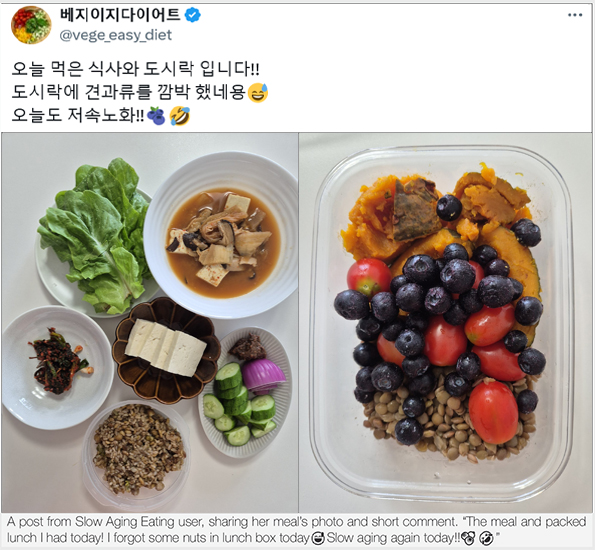The Chungbuk Times > Feature > View
Slow Aging, What Is It?
제 217 호 발행일 : 2024.09.02
“Slow aging” is a recent trend on social media. Other trends have focused on different aspects of food, including a variety of spices and flavors. However, slow aging primarily focusses on the health benefits of food, and people have now turned to health rather than taste. This article will introduce what slow aging is and find out why it caught the attention of many people.
Slow Aging Began Amid Irritating Food Trends
“Malatanghulu” is a new word combining malatang which is a Chinese spicy soup and tanghulu, a fruit dessert coated with melted sugar. It stems from youth eating malatang for a meal and tanghulu for dessert after it. According to the recent social media trend, spicy, sweet, salty and other tongue-stimulating foods such as rosé sauce-based food, mala sauce, tanghulu, yakgwa, etc. were popular among various age groups. According to Korea Customs Service’s import & export trade statistics, imports of Chinese sauces increased by more than 13,000 tons from 2019 to 2023. This is exactly when malatang began to become a common food for youth. Furthermore, according to Korea Agro-Fisheries & Food Trade Corporation’s food industry statistics, ice tanghulu and tanghulu ranked first and third among teenager’s frozen food search rankings. Tanghulu also ranked 11th and 12th in the same statistics for those in their 20s and 40s. However, what has recently emerged as a new trend is slow aging in pursuit of non-irritating food.
Slow aging is a biological concept that shows the aging of body functions at speed. The degree to which aging progresses is the same as the degree to which a person’s physical function declines, and at the time, the actual age of the person and the biological age of the body could be different. It is a way to slow down the rate of aging of the body, and one of the branches of health care. It has been started from consciousness of the rapidly aging body for a number of reasons, including nutritional imbalances in eating habits and consumption of popular food. The reason why people’s interest in low-speed aging has increased is young people are starting self-management due to the realization that those who are currently in their 30s and 40s are aging faster than their parents.
Fast Aging in the 30s and 40s, What are the Causes?
The reason for the fast aging rate among those in their 30s and 40s is that young people tend to eat food that is popular on SNS which are nutritionally unhealthy, more and more frequently. Professor Hyun Tae-sun from CBNU Dept. of Food and Nutrition said, “Malatang has a spicy and salty taste that stimulates the stomach, Tanghulu is a high-sugar food, and Dubai chocolate and cream bread are high in sugar and saturated fat. These foods are high in calories, and excessive consumption of these foods increases the risk of developing chronic diseases such as obesity, high blood pressure, and hyperlipidemia.” She strongly recommends choosing food wisely for individual health. Following by that, she added, “Frequent delivery foods, eating out, snacks, and late-night snacks harm people’s health. It is important to eat foods that belong to the five food groups (grains/meat, fish, eggs and beans/vegetables/fruits/milk and dairy) every day. The young generation of today eat a lot of calories and protein, but they lack vitamins and minerals, especially calcium. People should purposely check whether they have vegetables, fruits, milk or dairy products every day.”

According to Jung Hee-won, a professor of geriatric medicine at the Asan Medical Center in Seoul, who appeared on tvN’s You Quiz on the Block in 2023, the causes of the accelerating aging rate are a lack of exercise, nutritional imbalance, alcohol, tobacco, and stress and sleep habits. The dietary habits of modern people with increased intake of super processed foods such as ramen and snacks, animal fat and sugar cause nutritional imbalance. However, at the same time, physical activity had been decreased accelerating their body’s aging. In addition, alcohol and cigarettes are used to relieve stress, but in actuality it puts the body under more stress. If people are exposed to short-form content such as YouTube Shorts and Instagram Reels, they are momentarily drunk with dopamine, but when dopamine drops, the body gets stressed. Ironically, using a smartphone for a long time makes people very vulnerable to stress. Therefore, to prevent aging, it is important to “eat light, exercise consistently, and not to smoke and drink alcohol. They should also carefully manage time spent on their SNS,” said Dr. Jung.
According to Dr. Jung’s book Slow Aging Eating(저속노화 식사법), “Slow aging eating (Mediterranean-DASH Intervention for Neurodegenerative delay, MIND diet) limits the intake of animal and saturated fatty foods with an emphasis on natural plant foods, based on Mediterranean and DASH dietary components. It can reduce the risk of dementia by protecting brain health and cognitive function. MIND diet recommends eating more than a certain amount of vegetables, berries, nuts, olive oil, whole grains, and beans periodically, and limits the intake of red meat, cheese, butter, and fast food. It reduces the intake of fast food and refined grains naturally and changes the taste and body in a way that is familiar with non-irritating foods.
Interest in Slow Aging on Social media

Not only people in their 30s and 40s, but also people in their 20s are sharing their experiences with interest in low-speed aging on social media. Dr. Jung, who is active on X (formerly Twitter), communicates with his subscribers who formed a community called “Slow Aging Eating ” where they can share their opinions on slow aging eating. Community subscribers share informations including photos of foods that they ate, along with tips on how to eat healthily and make meals more delicious.
People who practice slow aging eating consume alternative grains such as brown rice, chickpeas, and lentils instead of refined carbonhydrates such as rice and breads. In addition, the rate of consumption of vegetables and fish is higher than red meat. Prof. Hyun commented “Lentil beans and chickpeas are legumes and quinoa are grains which are rich in vitamins and minerals such as high-quality vegetable protein, dietary fiber, folate, calcium, and iron, and are low in fat. Therefore, it is more helpful in reducing carbonhydrate as well as managing blood sugar, preventing constipation, and managing weight than meat, which is rich in animal protein. In addition to imported grains, soybeans (Seoritae, yellow beans), Dongbu, and kidney beans are locally grown and nutritionally excellent, so it would be better to include familiar foods produced in Korea in your diet,” she said.

CBNU student L (School of Electronics Engineeing, 21), who is practicing Slow Aging Eating, said, “While doing social media, I coincidently saw Dr. Jung’s post and felt the need to take care of my health even at a young age. Recently, I heard that the number of patients with diabetes and high blood pressure has increased even in the younger generation, so, when researcher of aging and health gave a frank admonition, it sounded more complicated and important,” revealing why she started to eat for Slow Aging. Since she decided to follow the MIND diet, she has reduced her usual ingestion of malatang, ice cream, and rosé tteokbokki by more than 50%, and has been eating mainly tofu and salads, etc. About her experience after the change in diet, she said, “Recently, as I eat more healthy foods such as salads, and I have less irritation from food, I feel better inside and digest smoothly. In the past, when I enjoyed sweet drinks, I felt blurry in my head, but that disappeared, so my concentration on daily life increased.”
“Substituting rice was the hardest thing. As I ate rice the most often, I was reluctant to try other grains. I can not eat lentils every time like everyone else, but I am making an effort to change over to brown rice. Even if I do not follow the MIND diet perfectly, I am gradually becoming more motivated to eat healthier,” she added.
Lastly, she said that altering eating habits, exercise routines, and lifestyle choices is not a simple task. She admitted that it had not been easy for her either. However, she emphasized the importance of making gradual changes one step at a time rather than feeling overwhelmed by the need to address everything at once. She said her chronic indigestion had improved gradually when she consumed nutritious food, and then she felt a sense of self-care and well-being. Her recommendation to others was embracing slow speed aging lifestyle.
By Ji Jae-lim
jlim0714@chungbuk.ac.kr